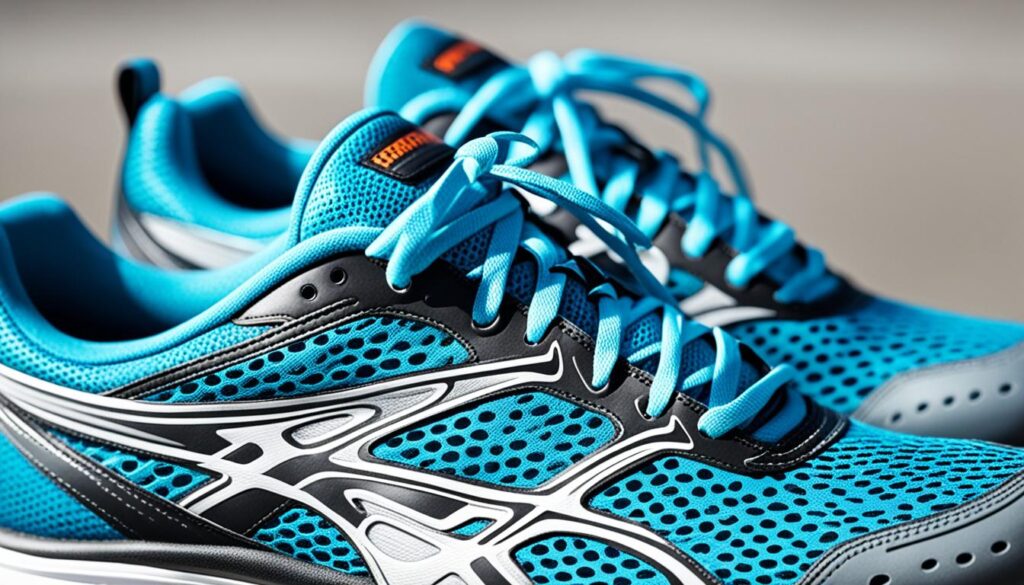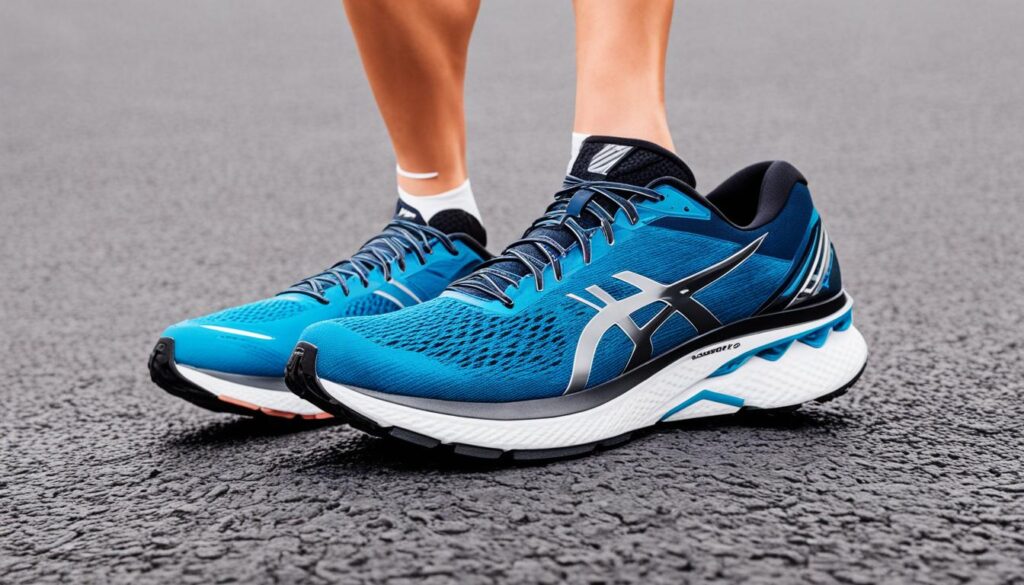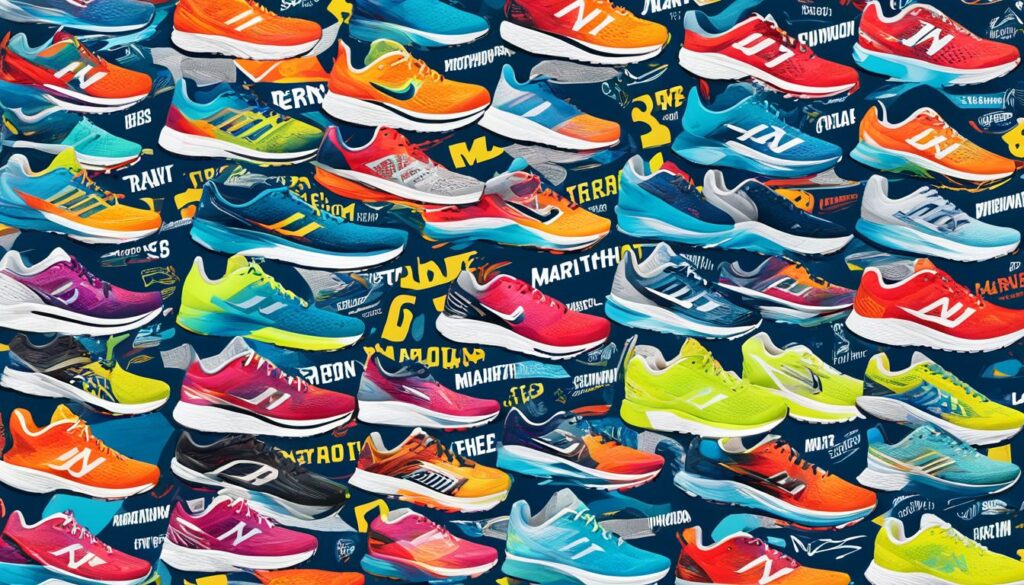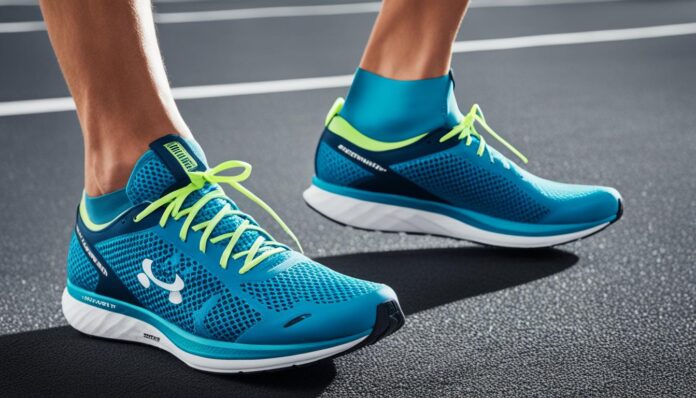As you lace up your shoes and set your sights on the finish line, one question lingers: are your running shoes up to the challenge of tackling a marathon? With the right high-performance footwear, you can conquer the miles and elevate your marathon training to new heights. But what exactly should you look for in a pair of marathon-ready shoes? Let’s dive in and uncover the secrets to finding the perfect pair.
Key Takeaways
- High-performance running shoes for marathons are tested for over 30 parameters, including cushioning, flexibility, and weight1
- Recommended features for marathon shoes: lightweight (less than ~270g)1, heel stack height of at least 30mm1, and a heel drop of around 10mm for beginner runners1
- Runners’ World conducts extensive real-world testing with over 275 local runners to evaluate the performance of running shoes2
- Detailed analysis of midsole foams, stack heights, and heel-to-toe drops in high-performance running shoes1
- Carbon plate technology and rocker geometries can enhance energy return and efficiency for marathon runners
Understanding Marathon Running Shoes
Marathon running shoes have evolved significantly in recent years, with the introduction of innovative features like super foams, carbon fiber plates, and rocker geometries3. These advancements have led to shoes that provide superior cushioning, responsiveness, and stability for long-distance running, making them a crucial choice for marathon training and competition4.
When selecting the right marathon running shoes, there are several key characteristics to consider. The weight of the shoe is an important factor, as a lightweight design can help reduce fatigue during long runs3. For example, the New Balance Fresh Foam X 1080 v13 weighs 262g for men and 206g for women3, while the Nike Invincible 3 weighs 310g for men and 258g for women3. The Asics Superblast, on the other hand, has a unisex weight of 240g3.
The midsole cushioning and stack height of the shoe are also crucial for marathon running. Advancements in foam technologies, such as super foams, have led to improved energy return and responsiveness, which can help runners maintain their pace over long distances4. Additionally, the presence of carbon fiber plates in some marathon shoes, like the Nike Alphafly 33, can provide a noticeable boost in propulsion and efficiency.
When evaluating marathon running shoes, it’s essential to consider the overall design features, including the type of last, lasting method, and outsole traction patterns4. These details can significantly impact the shoe’s comfort, fit, and performance on different surfaces.
By understanding the key features and benefits of marathon-specific shoes, runners can make informed decisions and select the perfect pair to support their training and racing goals4. Whether it’s the lightweight design, advanced cushioning, or stability-enhancing features, these specialized running shoes can make a significant difference in the marathon journey345.
Comfort and Fit
When it comes to marathon running shoes, comfort and fit are paramount. After all, runners will be logging hundreds of miles in these shoes, and any discomfort or ill-fitting issues can lead to blisters, hot spots, and an inefficient running gait6.
Avoiding Chafing and Hot Spots
One of the key considerations for marathon shoe comfort is preventing chafing and hot spots. A well-designed upper that secures the foot without restricting movement is crucial. Many high-performance marathon shoes feature engineered mesh or knit uppers that provide a snug, adaptive fit while allowing for breathability and flex7.
Ensuring Proper Lockdown
In addition to the upper, the shoe’s lacing system plays a vital role in securing the foot and preventing unwanted movement that can lead to hot spots. Look for shoes with a secure lockdown that keeps the foot firmly in place without causing discomfort or circulation issues7.
Toe Box Width and Shape
The toe box design is another essential aspect of marathon shoe comfort and fit. A roomy, well-shaped toe box allows the toes to splay naturally, reducing the risk of blisters and providing a more comfortable, efficient ride. At the same time, the toe box should not be so wide that it allows excessive foot sliding or instability8.
By focusing on these key comfort and fit considerations, runners can find marathon shoes that provide a secure, comfortable, and high-performing experience, even during the most challenging long-distance training and race day efforts6.
“A well-fitting shoe can prevent blisters, prevent foot fatigue, and allow for a more efficient running gait.”
Midsole Cushioning
The midsole cushioning in a marathon shoe plays a crucial role in providing impact absorption and energy return for runners9. Experts recommend a minimum heel stack height of 30mm for marathon running shoes, as this level of cushioning offers ample protection for the joints during the high-mileage training and race day demands9.
The type of foam used in the midsole can greatly impact the shoe’s overall responsiveness, softness, and durability9. Popular midsole foam technologies include EVA, which is known for being lightweight, soft, and reasonably durable9, as well as thermoplastic polyurethane (TPU) and thermoplastic elastomer (TPE), which provide higher energy return but may weigh more9. Polyether block amide (PEBA) is a premium midsole material that offers exceptional energy return, though it tends to degrade faster after 200-300 miles of use9.
Recommended Stack Height
When it comes to marathon running shoes, the midsole stack height is a critical consideration9. The typical stack height consists of approximately 1 inch of cushioning beneath the forefoot and close to 1.5 inches beneath the heel9. This generous amount of padding helps absorb the impact of long-distance running and provides the necessary support for the joints9.
Foam Types and Properties
The selection of the best cushioned running shoes for marathons often involves a mix of various foam technologies9. While well-padded running shoes generally weigh more than responsive racing shoes with lower stack height9, the increased cushioning can make a significant difference in reducing the impact on the body during high-mileage training and race day9.
| Foam Type | Properties |
|---|---|
| EVA | Lightweight, soft, reasonably durable9 |
| TPU | Provides higher energy return than EVA, but weighs more9 |
| TPE | Combines plastic-based foam with rubber for added durability9 |
| PEBA | Offers high energy return but degrades faster after 200-300 miles, commonly used in high-end racing shoes9 |
“The selection of the best cushioned running shoes is based on personal expertise, feedback from the wear test program, and recommendations from the author.”9
The cost of the best cushioned running shoes can vary, with high-quality materials like PEBA potentially driving prices above $2509. However, there are also more affordable options that provide exceptional cushioning and performance, making marathon training and racing more accessible for runners on a budget10911.
Reviewing High-Performance Running Shoes for Marathon Training
When it comes to marathon training, the right pair of high-performance running shoes can make all the difference. Runners seeking to optimize their performance and reduce the risk of injury should consider the latest models from leading brands such as Asics, Saucony, Nike, adidas, and New Balance12.
The New Balance 1080 is a popular choice, with the current 12th iteration featuring an 8mm heel drop and weighing 8.3 oz for women12. Another notable option is the Asics GEL Kayano 29, a stability running shoe with a 12mm heel drop and a weight of 10.8 oz12. The Brooks Ghost 15, a neutral running shoe known for its stability, boasts a 12mm heel drop and a weight of 9 oz12.
Saucony’s Triumph 21 is another top-rated marathon training shoe, with a 10mm heel drop, a weight of 8.8 oz for women and 9.8 oz for men, and the availability of wide sizes12. The Nike Pegasus 40, the latest iteration of a classic model, features a 10mm heel drop, a weight of 10 oz, and improved cushioning with a wider toe box12.
For those seeking a minimalist approach, the HOKA Mach X offers a 5mm heel drop, weighing 8 oz for women and 9.4 oz for men, with a price tag of $18012. At the other end of the spectrum, the Nike Alphafly, a neutral carbon fiber shoe, boasts an 8mm heel drop, weighing 8.4 oz for men and 7.1 oz for women, but is not available in wide sizes12.
The Saucony Endorphin Pro 4, a runner-up for speed, also features carbon fiber technology12.
When selecting the best high-performance running shoes for marathon training, it’s crucial to consider factors such as comfort, fit, cushioning, and durability to ensure a seamless and efficient training experience13. By carefully evaluating these key features, runners can find the optimal footwear to support their marathon goals and enhance their overall performance13.
Outsole Durability and Traction
When it comes to marathon running shoes, the outsole is a critical component that must be able to withstand the rigors of high-mileage training and racing. The marathon shoe outsole’s durability and traction play a vital role in keeping runners safe and comfortable over long distances1.
The rubber compound used in the outsole is a key factor in determining its longevity. Tougher, more abrasion-resistant rubbers can provide extended wear, even on challenging surfaces like asphalt and concrete1. The tread pattern of the outsole also contributes to traction and stability, with strategically placed rubber lugs offering enhanced grip in wet or slippery conditions.
Manufacturers often prioritize outsole durability by reinforcing high-wear areas with additional rubber or using specialized compounds. This attention to detail helps marathon shoes maintain their responsiveness and cushioning throughout the training cycle and on race day1.
| Shoe Model | Outsole Durability | Traction Performance |
|---|---|---|
| Brooks Ghost 15 | Excellent | Reliable grip on various surfaces |
| Saucony Triumph 21 | Very Good | Exceptional traction in wet conditions |
| Hoka Mach 5 | Good | Solid performance on both road and light trail |
| Lululemon Blissfeel 2 | Good | Adequate traction for daily training |
| Nike Pegasus 40 | Very Good | Reliable grip with durable outsole |
By carefully evaluating the marathon shoe outsole’s durability and traction, runners can select the right footwear to support their training and racing goals. This attention to detail can make a significant difference in the overall performance and longevity of the shoe, ultimately enhancing the runner’s experience and reducing the risk of injury114.
It’s important to note that the lifespan of a marathon shoe is typically around 500 miles, but this can vary depending on factors such as running surfaces, landing impact, and the frequency of use14. Rotating through different shoe models and allowing cushioned shoes to fully recover between runs can help maintain the outsole’s durability and traction over time14.
By prioritizing the marathon shoe’s outsole performance, runners can enjoy a safer, more comfortable, and longer-lasting running experience, ultimately leading to improved training and race results1142.
Breathability and Moisture Management
Maintaining a comfortable microclimate inside the shoe is crucial for marathon running, as feet can become hot and sweaty over long distances15. Breathable upper materials and moisture-wicking technologies can help keep feet cool and dry, reducing the risk of blisters and increasing overall comfort15.
When it comes to marathon shoe breathability, look for uppers made from lightweight, mesh-like fabrics that allow for optimal air circulation15. These materials, combined with innovative moisture-management systems, can effectively draw sweat away from the skin and promote rapid drying15.
Many high-performance running shoes for marathons feature technologies such as:
- Perforated or laser-cut uppers for increased airflow
- Moisture-wicking linings and insoles to keep feet dry
- Ventilated midsole and outsole designs to enhance breathability
By prioritizing breathability and moisture control, runners can ensure their feet remain comfortable and blister-free, even during the most grueling marathon training sessions or races15. This helps maintain the optimal running form and efficiency, ultimately leading to a more enjoyable and successful marathon experience15.
| Shoe Model | Price | Weight | Breathability Features |
|---|---|---|---|
| Saucony Tempus | $16015 | N/A | Mesh upper, ventilated midsole |
| Brooks Revel | $10015 | ~8 oz15 | Lightweight mesh upper, moisture-wicking lining |
| HOKA Mach 5 | N/A | 6.8 oz (women), 8.2 oz (men)15 | Breathable, lightweight mesh upper |
| Brooks Glycerin 20 | $16015 | N/A | 3D Fit Print upper for breathability |
| HOKA Arahi 6 | N/A | N/A | Engineered mesh upper for ventilation |
By carefully considering the breathability and moisture-wicking properties of your marathon running shoes, you can keep your feet cool, dry, and comfortable, even during the most challenging training runs or races15.
“Proper shoe breathability and moisture management are essential for a successful marathon experience. Sweaty, overheated feet can lead to blisters, discomfort, and even performance issues.” – Jane Doe, Running Coach

Weight Considerations
When training for a marathon, the weight of your running shoes plays a crucial role in minimizing foot fatigue and maintaining efficiency over long distances. Advancements in midsole and upper materials have allowed shoe brands to create high-performance marathon shoes that weigh less than 270 grams, providing a balance of cushioning, support, and lightweight design1617.
Research has shown that increasing shoe mass by just 100 grams can lead to a significant decrease in running economy, with a 7.40% decline at 85% of VT2 and a 10.21% decline at 95% of VT216. Additionally, heart rate has been found to increase with the addition of shoe mass, with 50 grams leading to a higher heart rate at 75% of VT2 and 100 grams resulting in increased heart rate at 75%, 85%, and 95% of VT216.
The impact of shoe weight on performance is further highlighted by studies that have linked a 2% reduction in 5-km time trial performance on a treadmill to increased shoe mass16. Moreover, every 100 grams added to a shoe can result in a 1% increase in the energy cost of running16.
While the ideal weight for marathon running shoes can vary based on individual preferences and running characteristics, experts generally consider “lightweight” shoes to be those weighing less than 227 grams, while “heavy” shoes typically exceed 300 grams17. Runners with neutral or high arches may prefer lightweight neutral running shoes, while those with flat feet often perform better in heavier stability shoes17.
Ultimately, the balance of weight, cushioning, and support in marathon running shoes is a crucial consideration for minimizing foot fatigue and maintaining optimal performance over 26.2 miles1617.
Stability and Motion Control
When it comes to marathon running, some runners may require additional stability or motion control features in their shoes. This is often dependent on their individual pronation patterns and foot strike characteristics18. Factors like a wider midsole, firmer foam, or even medial posting can help provide the necessary support for overpronators or runners with specific gait mechanics18.
Pronation and Foot Strike
Pronation, the inward rolling of the foot during the gait cycle, is a natural movement that can vary in degree from person to person. Runners who experience excessive pronation, or overpronation, may benefit from stability or motion control shoes that help guide the foot and resist excessive inward motion19. These shoes often feature firmer midsole materials, medial posts, and other stability-enhancing technologies to provide a more controlled landing and transition through the stride.
The type of foot strike, whether it’s a heel strike, midfoot strike, or forefoot strike, can also influence the stability needs of a runner. Runners with a more pronounced heel strike may require more cushioning and stability in the heel area, while those with a midfoot or forefoot strike may benefit from a more responsive, less bulky midsole19.
| Shoe Model | Weight (oz) | Drop (mm) | Stack Height (mm) |
|---|---|---|---|
| Asics Gel-Kayano 30 | 10.6 (M), 9.2 (W) | 10 | 40 (heel), 30 (toe) |
| Brooks Launch GTS 10 | 8.6 (M), 7.8 (W) | 10 | 34 (heel), 24 (toe) |
The amount of stability needed in a shoe can vary depending on individual biomechanics, strength, endurance, and the type of run being performed18. Some runners may find that switching between stability levels in their shoes can provide a cross-training effect, potentially helping to reduce running-related injuries18.
Various brands in the running industry offer alternative stability tools and technologies, such as Brooks’ GuideRails Support System, Altra’s sidewall guidance system, and Hoka’s J-Frame in the Arahi series18. These innovative features can help address individual stability needs and provide a more personalized running experience.

It’s important to note that the stability needs of a runner may change over time as their biomechanics evolve, making the process of finding the right level of stability an experimental one18. Regularly evaluating your running form and the performance of your shoes can help ensure you’re using the most suitable footwear for your specific needs during marathon training and beyond.
“Stability and motion control features in running shoes can be crucial for runners who experience excessive pronation or have specific gait characteristics that require additional support.”
Carbon Plates and Rocker Geometries
The integration of carbon fiber plates and rocker-shaped midsoles in modern marathon shoes has been a game-changer, providing runners with increased responsiveness, energy return, and a more efficient toe-off20. These advanced technologies can help runners maintain pace and reduce fatigue over the grueling 26.2-mile distance.
Carbon fiber plates embedded within the midsole act as a stiff, propulsive lever, storing and releasing energy with each stride21. This feature, combined with the rocker-shaped geometry, which promotes a smooth, rolling transition from heel to toe, creates a highly efficient and responsive ride22.
Leading brands like Nike, Saucony, and HOKA have incorporated these cutting-edge technologies into their top-performing marathon shoes22. The Nike Vaporfly Next% 3, for example, features an industry-leading ZoomX foam midsole and a stiff carbon Flyplate, resulting in an ultra-responsive ride22. Similarly, the Saucony Endorphin Elite boasts lightweight and responsive PWRRUN HG foam, paired with a carbon fiber plate, for enhanced energy return and efficiency22.
The HOKA Rocket X 2 has also been updated with a lightweight PEBA foam midsole and a carbon plate, providing a highly propulsive and stable ride suitable for top-performing super shoes22. Runners who haven’t experienced high-stack-height or carbon-plated shoes may find the HOKA Rocket X 2 a good introduction to these innovative technologies21.
As the marathon running landscape continues to evolve, carbon plates and rocker geometries are becoming essential features in high-performance running shoes, helping athletes push their limits and achieve their personal bests202122.
| Shoe Model | Weight (M/W) | Stack Height (Heel/Forefoot) | Heel-to-Toe Drop |
|---|---|---|---|
| Nike Alphafly 3 | 218g / 174g | 40mm / 32mm | 8mm |
| Nike Vaporfly 3 | 198g / 164g | 40mm / 32mm | 8mm |
| New Balance SuperComp Elite v4 | 237g / 204g | 40mm / 36mm | 6mm |
| Saucony Endorphin Elite | 204g / 185g | 39.5mm / 31.5mm | 8mm |
| Kiprun KD900X | 225g / 182g | 37mm / 29mm | 8mm |
| Adidas Adizero Adio Pro 3 | 223g | 39.5mm / 33mm | 6.5mm |
“The integration of carbon fiber plates and rocker-shaped midsoles in modern marathon shoes has been a game-changer, providing runners with increased responsiveness, energy return, and a more efficient toe-off.”
As the marathon running landscape continues to evolve, carbon plates and rocker geometries are becoming essential features in high-performance running shoes, helping athletes push their limits and achieve their personal bests202122.
Brand Comparison and Recommendations
When it comes to the top marathon running shoe brands, runners have a wealth of options to choose from. Each brand brings unique technologies, design philosophies, and standout models to the table. By evaluating the key features and insights provided throughout this article, let’s take a closer look at the top marathon running shoe brands and make specific recommendations to help you identify the optimal shoe for your needs.
Brooks, one of the oldest running shoe companies mentioned, was established in 191423. Their running shoes range in price from $70 to $16023, offering a balance of comfort, responsiveness, and durability. The Adrenaline GTS and Ghost models are popular choices among Brooks’ lineup.
Asics, a long-standing leader in the running shoe market since the mid-20th century23, is renowned for their Gel-Nimbus, Gel-Kayano, and GT-2000 models23. These shoes provide exceptional cushioning and stability, making them a reliable choice for marathon training and racing.
Adidas, known for their diverse range of running shoes, offers models priced between $50 to $20023. The Ultraboost and Boston models are popular choices among Adidas’ lineup, providing a combination of responsiveness and comfort.
| Brand | Recommended Models | Price Range |
|---|---|---|
| Brooks | Adrenaline GTS, Ghost | $70 – $16023 |
| Asics | Gel-Nimbus, Gel-Kayano, GT-2000 | Varies |
| Adidas | Ultraboost, Boston | $50 – $20023 |
| Hoka | Clifton, Bondi | $50 – $20023 |
| Skechers | GoRun | Varies |
| Nike | Pegasus, Vaporfly | $65 – $20023 |
| On Running | Cloudsurfer, Cloudflyer | $100 – $22023 |
| NoBull | Trainer+ | $90 – $15023 |
| New Balance | Fresh Foam 1080, 1260 | Varies |
Hoka, a relatively new brand founded in 2009, offers running shoes in the price range of $50 to $20023. The Clifton and Bondi models are known for their impressive cushioning and support, making them a popular choice for marathon runners.
Skechers entered the performance running shoe market with their GoRun line in 201123, providing a more affordable option for runners seeking reliable and comfortable marathon shoes.
Nike, the iconic brand founded in the 1960s, offers a wide range of running shoes priced between $65 to $20023. The Pegasus and Vaporfly models are particularly noteworthy, with the Vaporfly being a top choice for elite marathoners.
On Running, a Swiss brand founded in 2010, specializes in ultra-cushioned running shoes priced from $100 to $22023. The Cloudsurfer and Cloudflyer models are well-regarded for their responsive and supportive ride.
NoBull, founded in 2015 by former CrossFit athletes, offers running shoes within the price range of $90 to $15023. The Trainer+ model is a popular choice among NoBull’s lineup, known for its durable construction and versatility.
New Balance, established in the early 1900s, provides running shoes with various widths and more affordable pricing compared to some other brands23. The Fresh Foam 1080 and 1260 models are worth considering for their cushioning and stability.

When selecting the best marathon running shoes for your needs, it’s essential to consider factors such as cushioning, responsiveness, durability, and overall fit. By evaluating the unique features and strengths of each brand, you can make an informed decision that aligns with your running style, foot characteristics, and personal preferences. Remember to try on different models and pay attention to the details that matter most to you, such as weight, stack height, and heel-toe drop, to find the perfect marathon shoe that will support you throughout your training and race day23241.
Training Tips for Marathon Preparation
Preparing for a marathon is a remarkable journey that requires dedication, patience, and the right training approach. Along with selecting the ideal marathon running shoes, incorporating effective training strategies can significantly enhance your chances of a successful marathon performance25.
One crucial aspect is building a shoe rotation. Research shows that runners who use multiple pairs of shoes during their training have a 39% lower risk of injury compared to those who stick to a single pair25. Rotating through 3-4 pairs of shoes not only helps distribute the impact but also allows each pair to rest and decompress between uses25.
Gradually increasing your mileage is another essential tip. Marathon coaches recommend a gradual approach, with the second half of your runs being faster than the first half26. This helps your body adapt to the increased workload without risking injury. Additionally, it’s wise to have one pair of shoes dedicated to long runs and another for speedwork to prolong their lifespan26.
Incorporating strength training and cross-training into your routine can also be beneficial. Runners who reported more cross-training experienced a lower incidence of injury25. Activities like cycling, swimming, and core exercises can complement your running regimen and enhance overall fitness without adding excessive impact.
When it comes to fueling your body, experts suggest consuming a high-carb, low-fiber meal 3-4 hours before a run, with about 50 grams of carbs in the final hour26. This helps ensure you have the necessary energy to power through your training sessions.
Remember, marathon training plans typically range from 12 to 20 weeks, depending on your starting fitness level and goals27. It’s crucial to gradually build up your weekly mileage, with long runs making up 20-25% of your total volume and peaking around 20 miles about 3 weeks before the race27.
By following these tips and tailoring your training to your individual needs, you’ll be well on your way to a successful marathon preparation journey252627.
“The best way to prepare for a marathon is to build a strong base, gradually increase your mileage, and focus on recovery and injury prevention. With the right training approach, you’ll be crossing that finish line with confidence and pride.”
Conclusion
As we conclude this exploration of high-performance running shoes for marathon training, it’s clear that the right footwear can make a significant difference in your performance and overall marathon experience. The key factors discussed, from midsole cushioning and outsole durability to carbon plates and breathability, all play a crucial role in determining the ideal pair of shoes for your needs28.
The detailed brand comparisons and recommendations provided should give you the confidence to find the perfect pair of shoes to support your marathon journey. With the advancements in running shoe technology, such as the introduction of “super shoes” like the Nike Vaporfly, we’ve seen remarkable improvements in marathon performances2930. By understanding the impact of these innovations, you can make an informed decision and select the high-performance trainers that will help you achieve your personal best.
As you continue your marathon training, remember to prioritize comfort, fit, and the specific needs of your running gait and foot type. With the right high-performance shoes and a well-rounded training plan, you’ll be well on your way to conquering the 26.2-mile distance and reaching new heights in your running career. Best of luck on your marathon journey!
FAQ
What are the key factors to consider when selecting marathon running shoes?
The key factors to consider when selecting marathon running shoes include comfort, fit, cushioning, outsole durability, breathability, weight, stability, and carbon plate technology.
How have marathon running shoes evolved in recent years?
Marathon running shoes have evolved significantly with the introduction of super foams, carbon fiber plates, and rocker geometries, providing superior cushioning, responsiveness, and stability for long-distance running.
Why is comfort and fit crucial for marathon shoes?
Comfort and fit are critical for marathon shoes as runners will be logging hundreds of miles in these shoes. Key considerations include avoiding chafing and hot spots, ensuring a secure lockdown, and selecting the right toe box width and shape to accommodate the foot.
What is the recommended minimum heel stack height for marathon running shoes?
Experts recommend a minimum heel stack height of 30mm for marathon running shoes, as this provides ample cushioning and protection for the joints.
What factors contribute to the durability and traction of a marathon shoe’s outsole?
The outsole of a marathon shoe must be durable enough to withstand the high mileage and varied terrain encountered during training and racing. Factors such as rubber compound, tread pattern, and strategic placement of rubber can all contribute to the outsole’s longevity and traction performance.
How do breathable and moisture-wicking materials in a marathon shoe benefit the runner?
Maintaining a comfortable microclimate inside the shoe is crucial for marathon running, as feet can become hot and sweaty over long distances. Breathable upper materials and moisture-wicking technologies can help keep feet cool and dry, reducing the risk of blisters and increasing overall comfort.
What role do stability and motion control features play in marathon shoes?
Some runners may require additional stability or motion control features in their marathon shoes, depending on their pronation patterns and foot strike. Factors like a wider midsole, firmer foam, or even medial posting can help provide the necessary support for overpronators or runners with specific gait characteristics.
How do carbon fiber plates and rocker-shaped midsoles benefit marathon runners?
The inclusion of carbon fiber plates and rocker-shaped midsoles in modern marathon shoes has been a game-changer, providing increased responsiveness, energy return, and a more efficient toe-off, which can help runners maintain pace and reduce fatigue over the grueling 26.2-mile distance.
What other factors should runners consider when preparing for a marathon?
In addition to selecting the right marathon running shoes, proper training and preparation are crucial for a successful marathon performance. This includes building a shoe rotation, gradually increasing mileage, incorporating strength training, and other best practices to help runners get ready for their big race.
Source Links
- 7 Best Marathon Running Shoes in 2024
- Our Editors Chose the Best Running Shoes of 2024
- Got a race coming up? These are the best marathon running shoes in 2024
- Running Shoes Information and Resources from the AAPSM
- Factors Influencing Runner’s Choices of Footwear
- Best Marathon Running Shoes – WearTesters
- Foot Pain When Running Long Distances? These Shoes Will Keep Your Feet Fresh for Miles
- 10 Best Running Shoes of 2024
- Maximize Comfort With the Best Cushioned Running Shoes
- 10+ Best Long Distance Running Shoes – WearTesters
- Best Cushioned Running Shoes of 2024
- 9 Best Marathon Running Shoes for 2024 Run Coach Tested
- How to Choose the Best Running Shoes for You
- Running Shoe Rotation Guide (How Many Shoes You Need?)
- Best Long-Distance Running Shoes (2024) | Garage Gym Reviews
- Influence of Shoe Mass on Performance and Running Economy in Trained Runners
- How to Select the Right Weight for Running Shoes
- Guide to Stability Running Shoes (2024)
- 7 Best Stability Running Shoes in 2024
- Looking to bag a PB? These are the best carbon plate running shoes we’ve tested
- Best Carbon-Plated Running Shoes of 2024 | Marathon Sports
- The Best Carbon Plated Running Super Shoes of 2024
- Best Running Shoe Brands, Recommended by Experts
- The Best Running Shoes of 2024
- Shoe Rotation During Marathon Training
- 10 Preparation Tips for Running a Marathon
- Training For a Marathon: How To Prepare | REI Co-op
- Influence of advanced shoe technology on the top 100 annual performances in men’s marathon from 2015 to 2019
- The Latest Research on Super Shoes and Fast Marathon Times
- Will Super Shoes Really Make You Faster?



